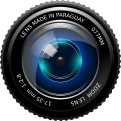Understanding the Basics of Food Photography
It's crucial to comprehend the fundamentals of what makes a great food shot before delving into the technical parts of food photography. A good food photograph should capture both the meal's look and the act of consuming it. It need to be aesthetically enticing and entice the observer to reach out and take a bite.
To achieve this it's important to consider the following elements when composing your shot:
Lighting: Good lighting is crucial in food photography. Natural light is best, but if that's not possible, use a diffused light source to avoid harsh shadows and unflattering highlights.
Color: The color of the food is just as important as the lighting. Make sure the colors are vibrant and appetizing, and avoid dull or washed-out hues.
Composition: The composition of the shot should be visually interesting and highlight the food in an appealing way. Experiment with different angles and perspectives to find the best shot.
Background: The background should complement the food and not distract from it. Consider using a simple neutral background that allows the food to be the star of the show.
Essential Camera Equipment for Food Photography
Once you are familiar with the fundamentals of food photography it's time to consider the tools you'll need. Although a highend camera and lens are not required for food photography, having the correct tools may greatly improve your pictures.
Here are some tools you'll need to get started:
Camera: A digital camera with manual settings is ideal for food photography. A high-megapixel camera will allow you to capture more detail and produce larger prints.
Lens: A macro lens or a 50mm lens is ideal for food photography. These lenses allow you to get close to the food and capture the fine details.
Tripod: A tripod is essential for keeping your camera steady and avoiding blurry photos.
Reflector: A reflector is a useful tool for reflecting light onto the food and filling in any shadows.
Techniques for Taking Amazing Food Photos
It's time to start capturing pictures now that you are familiar with the fundamentals of food photography and possess the necessary tools. To help you capture stunning food shots, consider the following advice and methods:
Experiment with different angles: Try taking photos from above, from the side, and from a low angle. Experimenting with different angles can give you a fresh perspective on your food and help you find the most visually appealing shot.
Play with the lighting: Experiment with different lighting setups to see how it affects the look of your food. Try using a diffuser or reflector to soften the light and fill in any shadows.
Use a shallow depth of field: A shallow depth of field is when only the subject of the photo is in focus and the background is blurred. This technique can be particularly effective in food photography as it helps draw attention to the food and makes it the star of the shot.
Edit your photos: Once you've taken your photos take some time to edit them. Use a photo editing software like Adobe Lightroom or Photoshop to adjust the colour, brightness and contrast of your images. You can also use editing tools to remove any blemishes or distractions from the background. It's important to keep the edits minimal and natural so the food still looks appetising and true to life.
Create a story with your images: In addition to capturing the dish's beauty, food photography also aims to capture the enjoyment of eating it. Consider using decorations and accessories to tell a story via your photos by capturing the ambiance and mood of the dinner. A tastefully laid table, a bottle of wine, or a book in the background may turn a plain plate of food into a scene.
Use texture: A key component of food photography is texture. By utilizing a narrow depth of field, taking close-up pictures, or experimenting with lighting you may emphasize the texture of your food.
Set the scene: Consider the overall look and feel of the scene you want to create with your food photography. Do you want a rustic, casual vibe or a more elegant, upscale feel? The choice of background, lighting and props can help set the tone and create the desired atmosphere.

